
|
|
Für die deutsche Fassung bitte nach unten scrollen
|
|
|
|
Important Roman Oil Lamps
from the Collection of the French Archaeologist Suzanne Gozlan (1921-2022)
|

|
|
|
She was an expert for Roman North Africa, the mosaics from Carthage and the architecture after the Punic Wars. She taught in Chartres as well as at the Sorbonne in Paris. Personally, she also loved the extraordinary of ancient art. When the French archaeologist Suzanne Gozlan passed away with 101 years in July last year, she left behind a small, but fine selection of Roman oil lamps. We proudly present in this special newsletter the most important pieces of this collection, which was established in the 1970s.
|
The highlight is for sure the clay lamp dating to the late 2nd century A.D., which shows a villa rustica. Such a detailed, architectonic depiction of a Roman country house is usually only known from mosaics. A museum-quality object is also the lamp with the goddess Victoria holding a tropaion in front of a consecration altar and flanked by dancing Lares. It is a celebration of a Roman victory – with delicacy and richness of detail that is hardly known from any other oil lamp.
|
SAVE THE DATE: On 11 October at 6 p.m. we inaugurate in our showroom in Vienna the major autumn exhibition "Alexander and the Hellenism". We are looking forward to your visit!
|
|
Bedeutende römische Öllampen aus der Sammlung der französischen Archäologin Suzanne Gozlan (1921-2022)
|
Sie war Expertin für das römische Nordafrika, die Mosaike Karthagos und die Architektur nach den punischen Kriegen. Sie unterrichtete in Chartres und an der Sorbonne in Paris. Und sie liebte auch privat das Besondere an der antiken Kunst. Als die französische Archäologin Suzanne Gozlan im Juli des Vorjahres mit 101 Jahren starb, hinterließ sie eine kleine, aber feine Sammlung römischer Öllampen. Die bedeutendsten Exemplare aus dieser Kollektion, die in den 1970er Jahren zusammengetragen wurde, dürfen wir Ihnen in diesem Sonder-Newsletter vorstellen.
|
Highlight ist sicher die Tonlampe aus dem Ende 2. Jahrhunderts nach Christus, die hinter einem Reisewagen eine Villa Rustica zeigt. Eine derart detaillierte architektonische Darstellung eines römischen Landhauses kennt man sonst nur von Mosaiken. Ein museales Stück ist auch die Lampe mit der Göttin Victoria mit Tropäum, Weihealtar und tanzenden Laren. Hier wird ein römischer Sieg gefeiert – in Feinheit und Detailreichtum, wie man es von kaum einer anderen Öllampe kennt.
|
|
SAVE THE DATE: Am 11. Oktober um 18.00 Uhr eröffnen wir in unserem Showroom in Wien die große Herbst-Ausstellung "Alexander und der Hellenismus". Wir freuen uns auf Ihr Kommen!
|
|
|
|
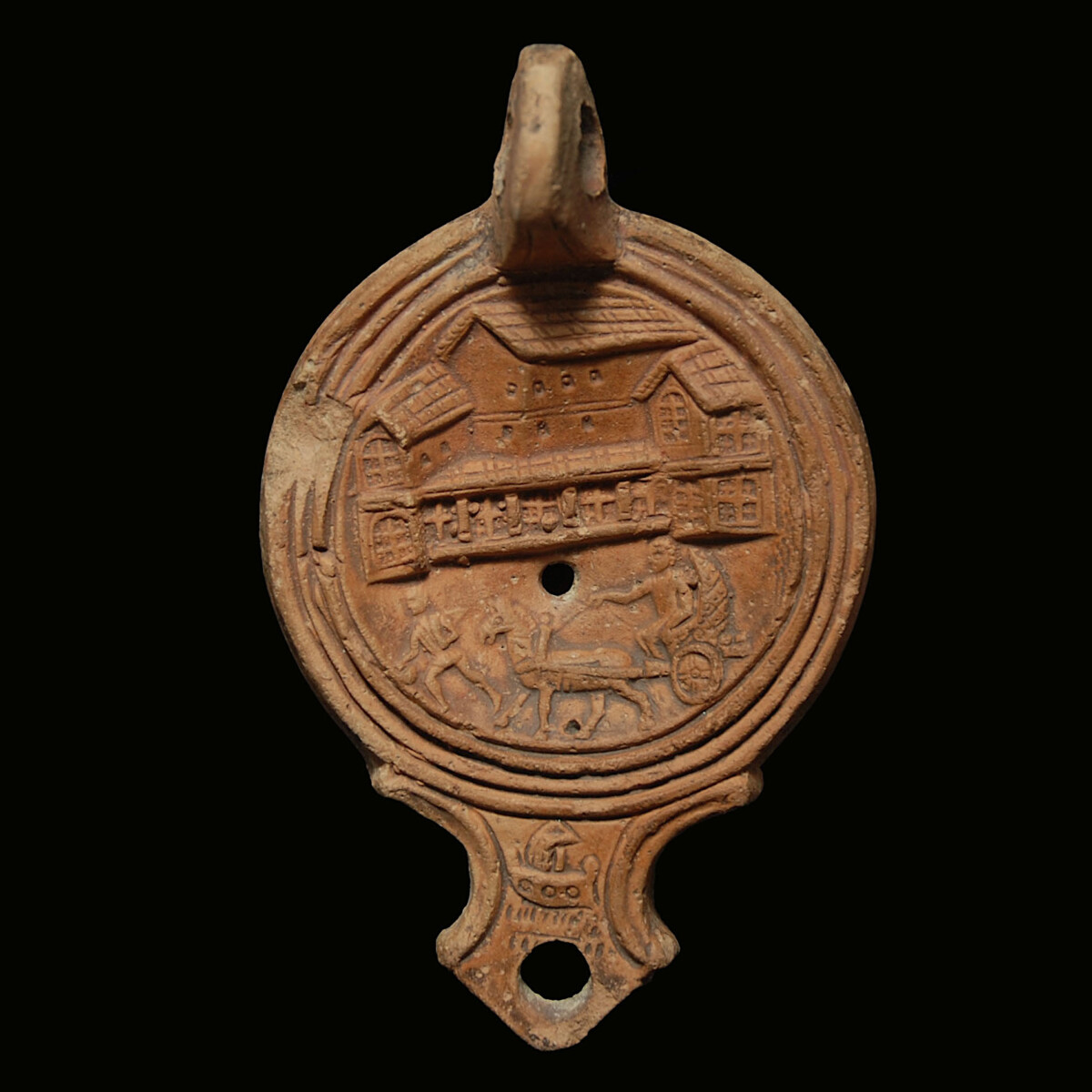
|
|
|
|
|
|
Roman Empire – Late 2nd century A.D.
|
A unique and correspondingly important clay oil lamp with a detailed image depicting Roman goods traffic from a villa rustica to a sailing ship. The large lamp, modelled from a form, has a long, triangular snout, which is strongly pulled in at the sides and framed by volutes. At the front is the nozzle, immediately followed by the pictorial depiction. It shows a goods ship sailing to the left. The round main image area in the mirror of the lamp is framed by even grooves. It is of particular importance because of the detailed depiction of a villa rustica, a Roman country house from the late 2nd century. The multi-storey Roman villa with a gabled roof and small windows rises in the background. The side wings also have gabled roofs, but with large angular and round windows. A covered porch with columns runs between the multi-storey parts of the building. In the foreground, possibly the owner of the villa can be seen to the left in his small, horse-drawn, two-wheeled carriage. He holds the reins with one hand. Behind him rises the semicircular sunshade on the traveling carriage. An errand boy runs in front of him. He holds a jug in his right hand and in his left the loop of a bag that hangs over his shoulder. The lamp has a ring-shaped handle at the back with two small grooves on the front and stands on a foot ring. The bottom with an ancient repair. See for the size and shape the oil lamp in the British Museum with Registration Number 1814,0704.106.
Dimensions: 14 cm long
Price: 12 000 Euro
|
|
|
Römisches Reich – Ende 2. Jahrhundert n. Chr.
|
Einzigartige und entsprechend bedeutende Öllampe aus Ton mit detaillierter Bildfläche, die einen römischen Warenverkehr von der Villa Rustica bis zum Segelschiff zeigt. Die große, aus der Form gearbeitete Lampe hat eine lange, dreieckige Schnauze, die seitlich stark eingezogen ist und von Voluten begrenzt wird. Vorne ist das Brennloch, gleich daran anschließend beginnt die bildliche Darstellung. Sie zeigt ein nach links segelndes Warenschiff. Die runde Hauptbildfläche im Spiegel der Lampe wird von gleichmäßigen Rillen begrenzt. Sie ist aufgrund der detaillierten Darstellung einer Villa Rustica, eines römischen Landhauses aus dem Ende des 2. Jahrhunderts, von besonderer Bedeutung. Im Bildhintergrund erhebt sich die mehrstöckige römische Villa mit Giebeldach und kleinen Fenstern. Die seitlichen Flügel weisen ebenfalls Giebeldächer auf, verfügen aber über großflächige Kasten- und Rundfenster. Zwischen den mehrstöckigen Gebäudeteilen verläuft eine überdachte Veranda mit Säulen. Im Bildvordergrund ist wohl der Besitzer der Villa auf seinem kleinen, von einem Pferd gezogenen, zweirädrigen Wagen nach links zu sehen. Er hält mit einer Hand die Zügel in der Hand. Hinter ihm erhebt sich der halbrunde Sonnenschutz am Reisewagen. Vor ihm eilt ein Laufbursche. Er hält eine Kanne in der rechten Hand und links die Schlaufe eines Säckchens, das ihm über die Schulter hängt. Die Lampe hat hinten einen ringförmigen Griff mit zwei kleinen Rillen auf der Vorderseite und steht auf einem Standring. Die Unterseite mit antiker Reparatur. Vergleiche zu Größe und Form die Öllampe im British Museum mit der Registration Number 1814,0704.106.
Länge: 14 cm
Preis: 12.000 Euro
|
|
|
|

|
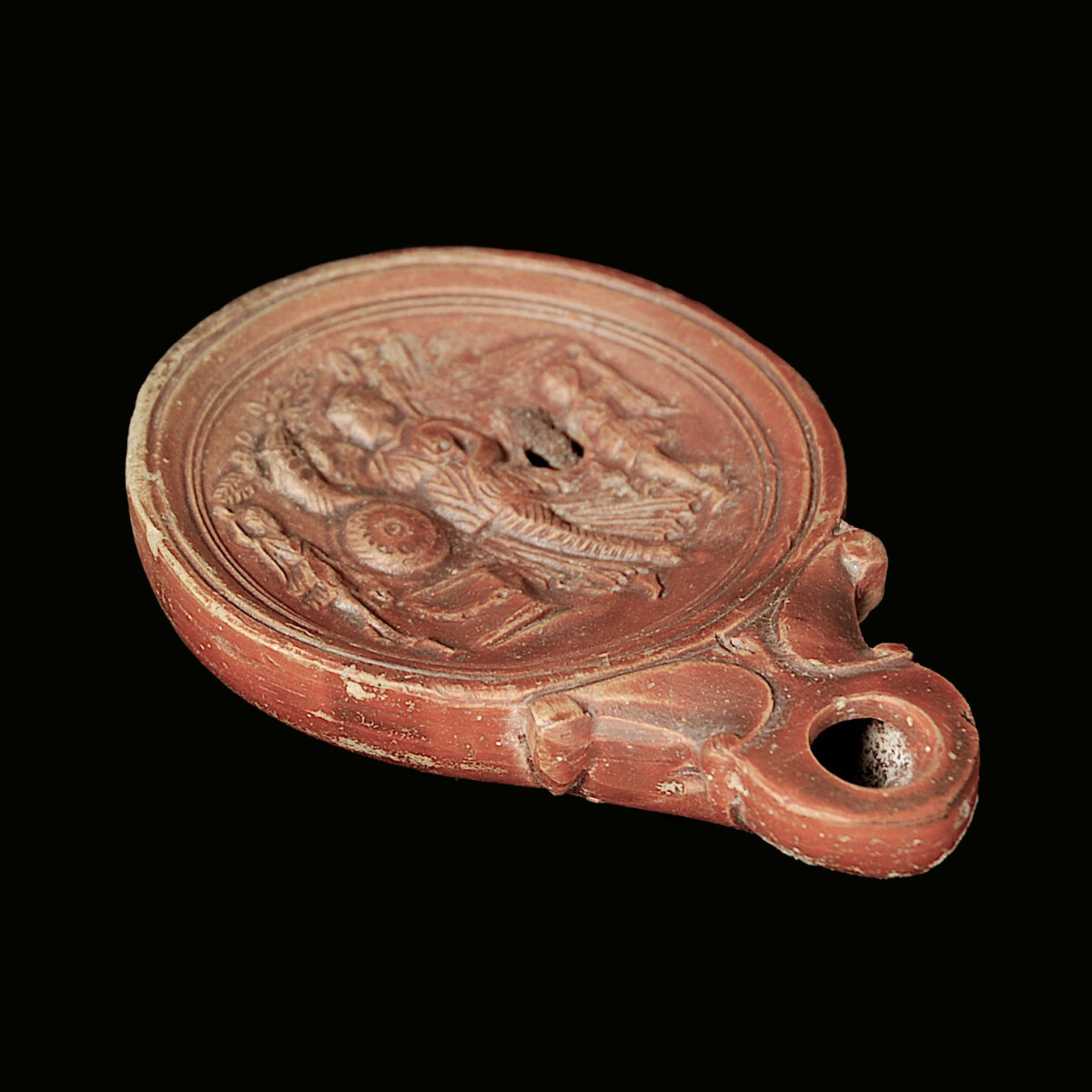
|
|
|
|
Roman Empire – 2nd century A.D.
|
Large, important oil lamp of the Loeschke IV type with a round nozzle and volutes on the neck that end in buttons. The round mirror is decorated with a tremendously detailed relief, which depict a winged Victoria and two Lares. The goddess of victory floats with a tropaion above her left shoulder in front of a garland-decorated consecration altar on which a victory shield (Clypeus) is placed under a cornucopia. Her gaze is to the left to the altar. Two youthful Lares are dancing on the left and right of her, they hold crowns above their heads and each one a lantern in their hand. Remains of the corroded wick are still preserved in the filling hole behind Victoria. The mirror with the image area is framed by grooved circles. A rare, important terracotta oil lamp.
Dimensions: 12.3 cm long
Price: 10 000 Euro
|
|
|
Römisches Reich – 2. Jahrhundert n. Chr.
|
Große, bedeutende Öllampe des Typs Loeschke IV mit rundem Brennloch und Voluten am Hals, die in Knöpfen enden. Der runde Spiegel ist mit einem ungemein detaillierten Relief geschmückt, das die geflügelte Victoria und zwei Laren zeigt. Die Siegesgöttin schwebt mit einem Tropäum über ihrer linken Schulter vor einem girlandengeschmückten Weihealtar, auf dem ein Siegesschild (Clipeus) unter einem Füllhorn „Cornucopia“ platziert ist. Ihr Blick ist nach links zum Altar gerichtet. Links und rechts von ihr tanzen zwei knabenhafte Lare, sie halten Kronen über ihre Köpfe und je eine Laterne in der Hand. Im Einfüllloch hinter Victoria sind noch Reste des korridierten Dochtes erhalten. Der Spiegel mit Bildfläche ist von gerillten Kreisen umgeben. Eine seltene, bedeutende Öllampe aus Ton.
Länge: 12,3 cm
Preis: 10.000 Euro
|
|
|
|
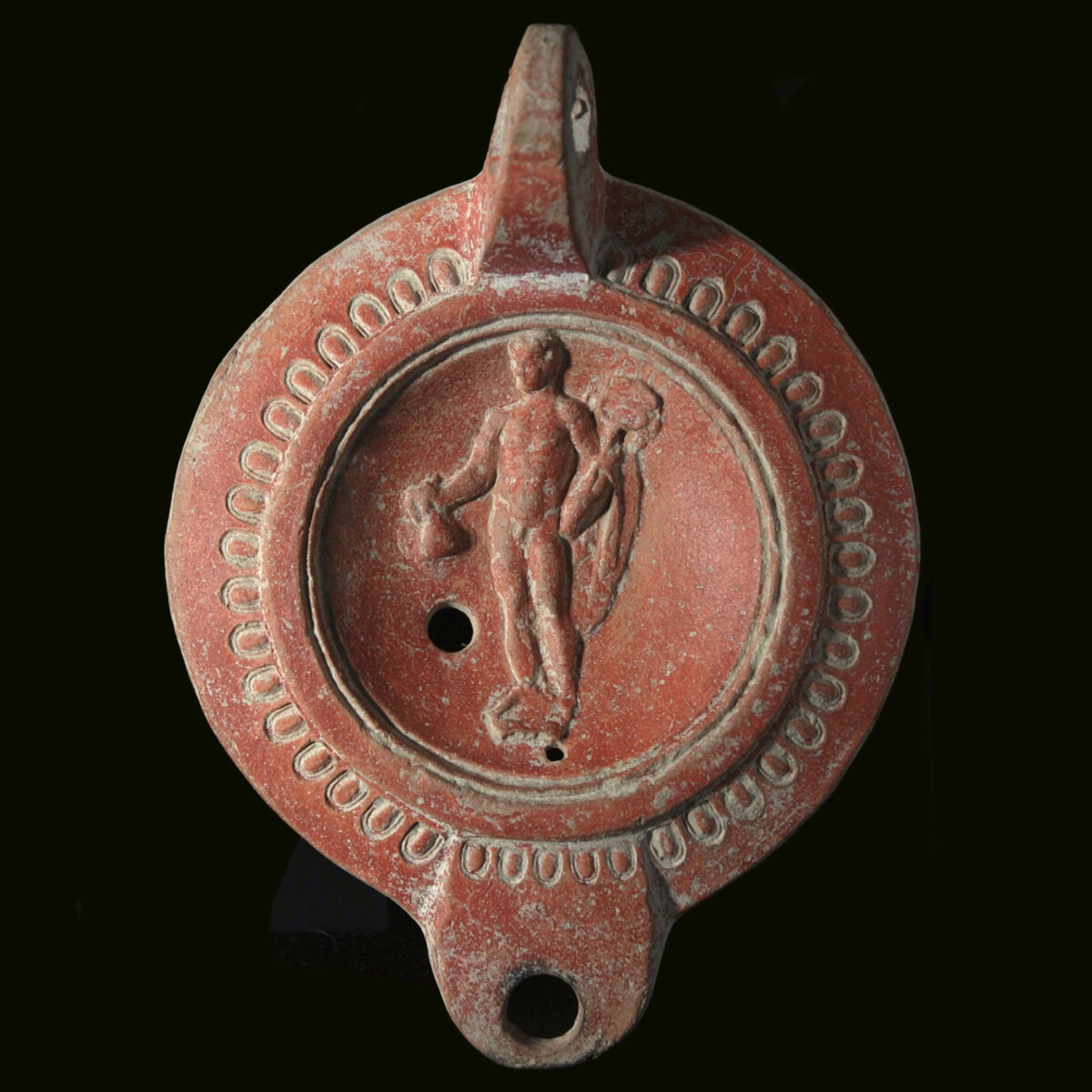
|
|
|
|
|

|
|
Roman Empire/Northern Africa – 2nd-3rd century A.D.
|
Very large, important reddish clay oil lamp of the Loeschke VIII type, which was made in northern Africa. The round mirror depicts an unclothed Mercury with a winged hat (petasos), who holds in his right hand the moneybag, and in his left one the caduceus, the staff as a symbol of commerce. The travel cloak, the so-called chlamys, is thrown over his left arm. A large and a small pouring and wick hole respectively are in the lower part of the image area. The shoulder is decorated with encircling stamped egg-and-dart pattern. The simple round nozzle is slightly raised and has traces of smoke. The bottom of this very rare lamp is on the front decorated with wine leaves, tendrils and grapes. On the smooth bottom the manufacturer’s name KDOMISES is engraved. A massive ring handle starts from the shoulder to the bottom. With an old label of the auction house Drouot at the bottom.
Dimensions: 17.5 cm long
Price: 4 800 Euro
|
|
|
Römisches Reich/Nordafrika – 2.-3. Jahrhundert n. Chr.
|
Sehr große, bedeutende Öllampe des Typs Loeschke VIII aus rötlichem Ton, die in Nordafrika gefertigt wurde. Der runde Spiegel zeigt den unbekleideten Merkur mit geflügelter Kappe („Petasos“), der in seiner rechten Hand den Geldbeutel und in seiner linken den Caduceus, den Heroldsstab als Symbol des Handels hält. Den Reisemantel, die sogenannte „Chlamys“ hat er über den linken Arm geworfen. Ein großes und ein kleines Einfüll- bzw. Dochtloch befinden sich im unteren Teil der Bildfläche. Die Schulter ist umlaufend mit einem gestempelten Eierstabmuster verziert. Die einfache Rundschnauze ist leicht angehoben und weist Schmauchspuren auf. Die Unterseite dieser sehr seltenen Lampe ist vorne mit Weinblättern, Ranken und Trauben verziert. Auf der glatten Standfläche ist der Herstellername „KDOMISES“ eingeritzt. Ein mächtiger Ringhenkel setzt an der Schulter an und läuft an der Unterseite aus. Mit altem Etikett des Auktionshauses Drouot an der Unterseite.
Länge: 17,5 cm
Preis: 4.800 Euro
|
|
|
|
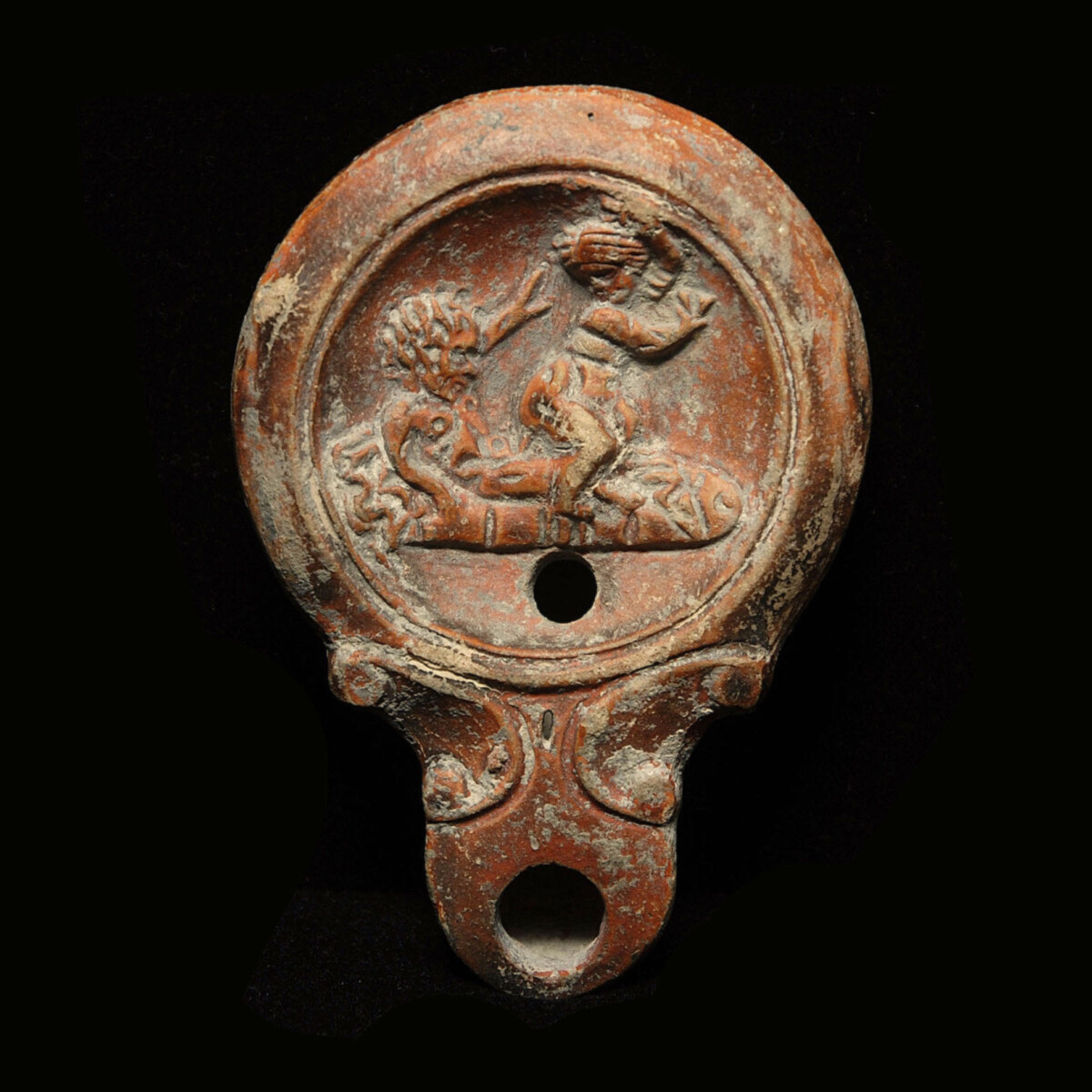
|
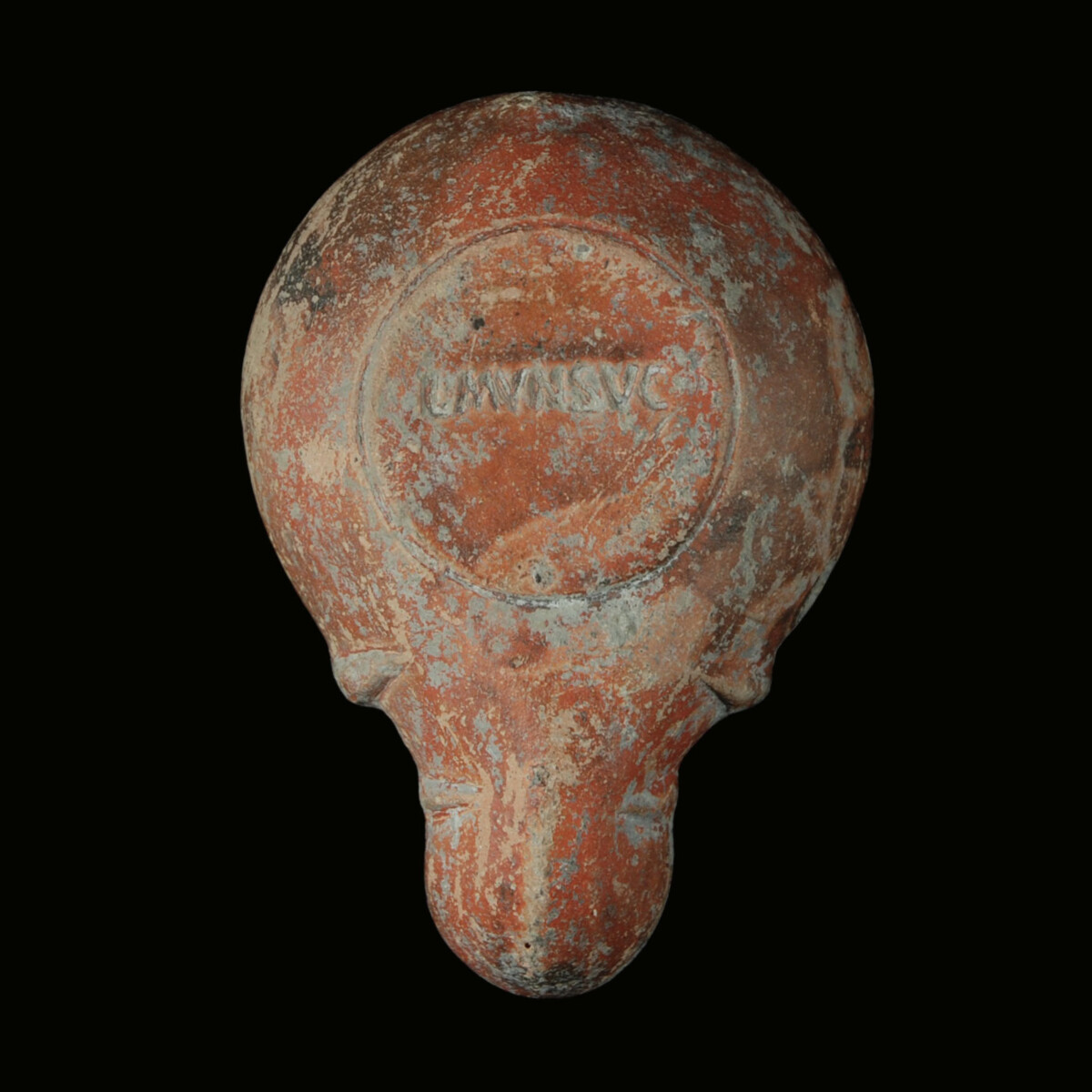
|
|
|
|
Roman Empire – 1st century A.D.
|
Signed oil lamp of brown clay without handle of the Loeschcke IV type. The high quality relief on the mirror depicts a dwarf couple making love on pillows in the form of an overlarge phallus. She has her arms stretched out, sits on him and looks around. The male dwarf with a large head and thick curls leans with the right elbow on the kline and stretches the left one upwards. Below the scene is the round pouring hole. The depiction is framed by a flute, followed by the semicircularly sloping shoulder. The round snout with a large nozzle is separated from the mirror by two volutes, which merge into buttons. The lamp stands on a ring foot stamped with the manufacturer's mark “LMVNSVC”. See for the type the oil lamp in Vindonissa Museum in Brugg/Aargau, Switzerland with the inventory number 41.276, 3431 and 3432, published in: “Sexual art on Roman lamps: analysis of provincial data” in: Journal of Roman Archaeology 36 (2023), p. 23-49.
Dimensions: 9.6 cm long
Price: 2 400 Euro
|
|
|
Römisches Reich – 1. Jahrhundert n. Chr.
|
Signierte Öllampe ohne Griff aus braunem Ton des Typs Loeschke IV. Das hohe und sehr plastische Relief am Spiegel zeigt ein Zwergenpaar beim Liebesspiel auf Pölstern, die die Form eines übergroßen Phallus haben. Sie, die Arme nach vorne gestreckt, sitzt dabei auf ihm und blickt sich um. Der männliche Zwerg mit großem Kopf und dicken Locken stützt sich mit dem rechten Ellenbogen auf der Kline auf und streckt die linke nach oben. Unter der Szene das runde Einfüllloch. Die Darstellung wird von einer Rille gerahmt, die daran anschließende Schulter halbrund abfallend. Die runde Schnauze mit großem Brennloch wird durch zwei Voluten, die in Knöpfen auslaufen vom Spiegel getrennt. Die Lampe steht auf einer Standfläche, in die die Herstellermarke „LMVNSVC“ gestempelt wurde. Vergleiche zum Typus die Öllampen im Vindonissa Museum in Brugg/Aargau in der Schweiz mit den Inventarnummern 41.276, 3431 und 3432, publiziert in: Sanja Vucetic „Sexual art on Roman lamps: analysis of provincial data“ in: Journal of Roman Archaeology 36 (2023), S. 23-49.
Länge: 9,6 cm
Preis: 2.400 Euro
|
|
|
|
|
|
|
|
|
CHRISTOPH BACHER ARCHÄOLOGIE ANCIENT ART GmbH
|
Galerie: Stubenring 20, A-1010 Wien
Showroom: Untere Viaduktgasse 55, A-1030 Wien
|
|

|
|
|
|


